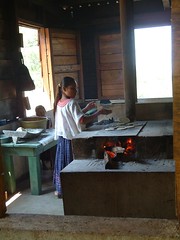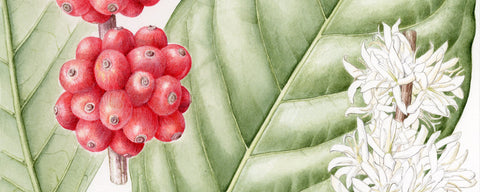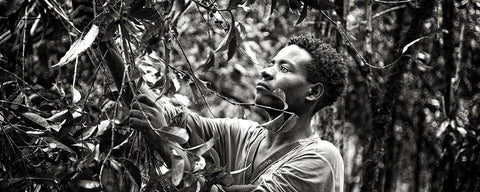First Published - July 5, 2009
Over the eight years we’ve been sourcing Santa Ana coffee we’ve managed to get out to the farm every few years. It’s amazing to be out here again, and see how the farm has evolved and matured. Driving from Guatemala City to Sierra de las Minas, Rony and I were talking about the early days of the farm.
The story of how Rony Asensio started his farm really demonstrates his motivation. He bought the land back in the mid 90’s—married with two young children he believed he was finally in a place to begin to fulfil his dream to start a coffee farm.
Rony’s family comes from “Genuine Antigua coffee rootstock”. His father had a coffee farm near the colonial city of Antigua; but when Rony was a young boy, his father died and his mother was unable to continue to look after the farm so it was sold.
Rony vowed that one day he would follow in has fathers’ footsteps and start his own coffee farm. But when he decided to take the first step, the land prices in Antigua (the most famous coffee growing region in Guatemala) was too expensive and Rony spent two years searching for the perfect location. He needed somewhere that he could afford and would give high altitude, rainfall and that magic soil to support the cultivation of high quality coffee trees.
Eventually he found land in the Sierra de las Minas mountain range in Morazan. He had to be persuasive to get the owner to sell the land to him; but after long negotiations, the deal was done and Rony began to create his coffee farm. He took advice from the legendary Luis Pedro Zelaya Senior, whose family has farmed coffee in Guatemala for generations, and who happens to be Rony’s father-in-law. It took meticulous planning to decide which varietals to plant at different sections around the farm, owing to the delicate microclimate. We reflected now, 15 years later, how this has ensured the coffee cherries ripen at a gradual rate through the harvest. This was critical in controlling the pace of coffee cherry delivery at the farms beneficio pulpers so that processing is never delayed and quality is not lost.
Rony planted the coffee trees and shade trees, and over the years we’ve seen the farm double in size. But it has been far from easy and has taken great tenacity. During the late 90s; when world coffee prices started to crash, Rony almost lost the farm. His brother-in-law, Luis Pedro Zelaya Jnr, put in an investment which saved him, and It was around this time Jeremy and I first started to source coffee from Santa Ana la Huerta. And now, so many years later, we can see how this long-term relationship has been an important factor: supporting Rony to keep his farm in production, and instead of abandoning it as was happening with so many farms in Central America at that time, actually seeing the quality increase!
Patience: I’m privileged to have seen how the farm has matured and expanded and to have seen the quality improvements that Rony has implemented. On this trip I’m impressed how Rony had upgraded and increased the number of electric pulpers so that now the coffee cherries are pulped without any delay. He’s greatly enlarged the drying patios to increase the amount and control of sun-drying. We think these have been integral in how the quality and complexity in the coffee has developed and is preserved.
The farm’s social compliance has also evolved to a new level that we’re really delighted to be associated with. Rony first talked with me about his plan to build high quality housing and amenities for the farm workers over five years ago, but he had to get the farm into profit first.
Then, three years ago, he showed me the blue prints, but it wasn’t until this trip that I saw the construction with my own eyes. It was amazing to think that through our ethical sourcing, focusing on paying a sustainable price for Santa Ana La Huerta, we’ve contributed towards improving the labour conditions on the farm. The payoff is that the good workers and expert pickers have come back to the farm though the season because they can appreciate what the farm provides them. The time spent training workers means that the knowledge is retained on the farm and has created a really good feeling among the workers.
After the harvest has been picked is an interesting time to visit the farm. The trees are in a state of exhaustion and need time to recover from yielding their crop. Hard systematic pruning—part of a 3 year cycle—is nearly completed for this year, and in some areas of the farm signs of new growth are starting to emerge. But Rony talks about how the timing of each task is critical. The weather has such a huge influence, and each task has to be undertaken with a patience and discipline, waiting for the rhythm of the season. Delay, and you lose the moment and the effect ripples through the season and can take year to get back into the cadence again. There’s still a significant workforce on the farm, mostly now involved in planting new young trees with Catuai and Bourbon varietals. Some workers only speak Q’eqchi’, a native language, and no Spanish! Fortunately for us, the farm managers speak Spanish & Q’eqchi’ which allows us to talk to each other. They tell me the auxiliary verbs are the same as English but I had to check Wikipedia to learn what they are.
I trundle with Rony & Edin on our quad bikes to the western side of the farm where Rony wants to show me his newest stewardship project now reaching its second year. The local Environmental agency permitted Rony to grow coffee in exchange for undertaking a re-forestation project. He planted 6000 cedar trees which I tell Rony are looking rather spindly. So he then wants to show me his first re-forestation project—this one 12 years old. It takes us about one hour to reach, and it’s a great blast practising my wheelie skills on the quad bike. Lightening is flashing in the far distance but we’re relaxed as it seems to be moving further away. We get to the massive cedar trees, creating impressive dense, thick woodland. The birds are piercingly shrill, and then the next moment lightening is on top of us. Rony calls to run back to the quad bikes and we go at full throttle. The rain starts violently, and I pull out my GAP pak-a-mac, amazed that in the 8 years of coffee travels that its been sitting in my holdall, this is the first time ever I’ve remembered to take it and hook it to my belt. Edin and Rony pull on plastic ponchos and we hurtle down the tracks with ponchos billowing out behind. The rain is getting torrential! It takes me back 6 years to the time I got caught in a hammering downpour crossing the centre of Lake Kivu, with Tim Schilling (PEARL) and Paul De Lucca (ACDI/ VOCA), in a tiny open motor launch. That day had started in brilliant sunshine and we’d gone to visit Copac co-operative on the north of the lake. On our return trip, the heavens opened and we had no waterproofs. In Rwanda I had learned my lesson the hard way.
Fortunately here in Guatemala the rain didn’t last and we got back to the farm mostly intact, apart from drenched 501’s.
In the near future, Rony’s son will be ready to take up the mantel and get involved in the stewardship of Santa Ana La Huerta. If there’s one thing Rony’s story teaches us, it’s that it takes a generation to create a coffee farm.





